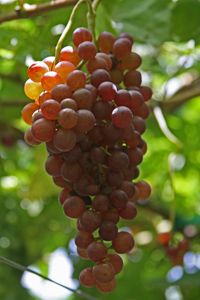|
‘Victoria Red’ Grape Variety
by
Jim Kamas and Larry Stein
Texas A&M AgriLife Extension Service Horticulturists
 The University of Arkansas, Texas A&M AgriLife and Tarkington Vineyards have released a Pierce’s disease (PD) tolerant grape variety named ‘Victoria Red’. Evaluated as Arkansas 1475, ‘Victoria Red’ was bred in 1971. It has been shown to be very tolerant to Pierce’s disease (Xylella fastidiosa) referred to as “PD”. Tolerant ancestors include ‘Villard Blanc’ (S.V. 12-375), ‘Jacquez’ (‘Black Spanish’, ‘Lenoir’), ‘Herbemont’, as well as the native Texas species Vitis berlandieri. The most significant characteristic of ‘Victoria Red’ is its sustained health, vigor and productivity in Coastal Texas, an area of the United States with extremely high Pierce’s disease (PD) pressure.
The University of Arkansas, Texas A&M AgriLife and Tarkington Vineyards have released a Pierce’s disease (PD) tolerant grape variety named ‘Victoria Red’. Evaluated as Arkansas 1475, ‘Victoria Red’ was bred in 1971. It has been shown to be very tolerant to Pierce’s disease (Xylella fastidiosa) referred to as “PD”. Tolerant ancestors include ‘Villard Blanc’ (S.V. 12-375), ‘Jacquez’ (‘Black Spanish’, ‘Lenoir’), ‘Herbemont’, as well as the native Texas species Vitis berlandieri. The most significant characteristic of ‘Victoria Red’ is its sustained health, vigor and productivity in Coastal Texas, an area of the United States with extremely high Pierce’s disease (PD) pressure.
It is a seeded grape with both large berries and clusters that are attractive and quite long with a bright red skin color. Average cluster weight at Tarkington Vineyards near Victoria exceeded one pound. The Tarkington Vineyards’ location is approximately 40 miles from the Gulf of Mexico and has very intense Pierce’s disease (PD) pressure. Vines at this location were vigorous and productive for twenty years while all other susceptible varieties died rapidly from PD.
‘Victoria Red’ is recommended primarily as a fresh-fruit cultivar for on-farm and local-market sales in USDA hardiness zones 7b or warmer. It has however ripened in excess of 24ºBrix (very sweet), making it a potentially valuable neutral blending wine grape or table grape (eating) for high PD risk areas. Both cluster size and berry size are outstanding with clusters averaging 477 grams and berries averaging 8 grams. At the Victoria evaluation site, ‘Victoria Red’ averaged 20 pounds per mature vine.
‘Victoria Red’ is typically a two seeded berry with an occasional third seed trace. In addition to yield and quality potential, ‘Victoria Red’ has loose clusters which appears to make it resistant to bunch rot organisms common on more tightly clustered varieties.
A major limitation of this variety is its lack of cold hardiness as it routinely suffered cane and trunk injury in West-Central Arkansas. It is recommended for planting across the deep and mid-southern United States in zone 7b or warmer. This is the San Antonio-Hill Country area.
|
|
|



